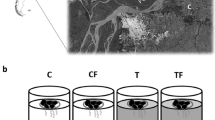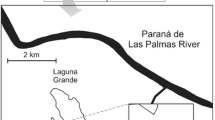Abstract
Experiments in laboratory stream channels compared the behaviour of Deleatidium mayfly nymphs in the absence of fish with that in the presence of either native common river galaxias (Galaxias vulgaris Stokell) or introduced brown trout (Salmo trutta L.). Galaxias present similar predation risks to prey during day and night but are more active at night. Whereas, trout present a higher predation risk during the day. Deleatidium maintained a fixed nocturnal drift periodicity that is characteristic of streams containing visually feeding fish regardless of the nature of the predation regime presented in the laboratory. However, the number on the substratum surface, and therefore able to graze algae, was lower when fish were present than when they were absent. The number was lower during the day in the presence of trout, when they present the highest predation risk, and lower during the night compared to the day in trials with galaxias when galaxias activity disturbs Deleatidium from the substratum. Increases in the probability of Deleatidium leaving a patch, reductions in the proportion of mayflies on high quality patches and reductions in the distance travelled from refuge also reflected variations in the predation regime. Similar differences in positioning were observed under the same predation regimes in in situ channels in the Shag River and these were associated with differences in algal biomass. Algal ash-free dry mass (AFDM) and chlorophyll a (chl a) were higher on the tops of cobbles when fish were present. Fish also affected the biomass and the distribution of algae on cobbles as AFDM and chl a were higher on the sides of cobbles from channels with trout compared to those with galaxias. Changes in grazing behaviour, caused by predator avoidance, are likely to have been responsible for differences in algal biomass because no significant differences were detected between treatments in the biomass of Deleatidium or of total invertebrates.
Similar content being viewed by others
References
Abrams PA (1991) Strengths of indirect effects generated by optimal foraging. Oikos 62: 167–176
Allan JD (1983) Predator-prey relationships in streams. In: Barnes JR, Minshall GW (eds) Stream ecology: application and testing of general ecological theory. Plenum, New York, pp 191–229
Allan JD, Flecker AS, McClintock NL (1986) Diel epibenthic activity of mayfly nymphs, and its non-concordance with behavioral drift. Limnol Oceanogr 31: 1057–1065
Allan JD, Flecker AS, Kohler SL (1991) Diel changes in epibenthic activity and gut fullness of some mayfly nymphs. Verh Int Verein Limnol 24: 2881–2885
Angradi TR, Griffith JS (1990) Diel feeding chronology and diet selection of rainbow trout (Oncorhynchus mykiss) in the Henry's Fork of the Snake River, Idaho. Can J Fish Aquat Sci 47: 199–209
Carpenter SR, Kitchell JF, Hodgson JR, Cochran PA, Elser JJ, Elser MM, Lodge DM, Dretchmer D, He X, Ende CN von (1987) Regulation of lake primary productivity by food web structure. Ecology 68: 1863–1876
Casey RJ (1987) Diel periodicity in density of Ephemeroptera nymphs on stream substrata and the relationship with drift and selected abiotic factors. Can J Zool 65: 2945–2952
Collier KJ, Winterbourn MJ (1990) Population dynamics and feeding of mayfly larvae in some acid and alkaline New Zealand streams. Freshwater Biol 23: 181–189
Cooper SD, Walde SJ, Peckarsky BL (1990) Prey exchange rates and the impact of predators on prey populations in streams. Ecology 71: 1503–1514
Dill LM (1987) Animal decision making and its ecological consequences: the future of aquatic biology and behaviour. Can J Zool 65: 803–811
Douglas PL, Forrester GE, Cooper SD (1994) Effects of trout on the diel periodicity of drifiting in baetid mayflies. Oecologia 98: 48–56
Flecker AS (1992) Fish predation and the evolution of invertebrate drift periodicity: evidence from neotropical streams. Ecology 73: 438–448
Flecker AS, Townsend CR (1994) Community-wide consequences of trout introduction in New Zealand streams. Ecol Appl 4: 798–807
Forrester GE (1994) Influences of predatory fish on the drift dispersal and local density of stream insects. Ecology 75: 1208–1218
Heise BA (1992) Sensitivity of mayfly nymphs to red light: implications for behavioural ecology. Freshwater Biol 28: 331–336
Kerfoot WC, Sih A (1987) Predation: Direct and indirect impacts on aquatic communities. University Press of New England, Hanover
Lima NR, Dill LM (1990) Behavioural decisions made under risk of predation: a review and prospectus. Can J Zool 68: 619–640
Lythgoe JN (1988) Light and vision in the aquatic environment. In: Atema J, Fay RR, Popper AN, Tavolga WN (eds) Sensory biology of aquatic animals. Springer, Berlin Heidelberg New York, pp 57–82
McIntosh AR, Townsend CR (1994) Interpopulation variation in mayfly anti-predator tactics: differential effects of contrasting predatory fish. Ecology 75: 2078–2090
McIntosh AR, Townsend CR (1995a) Contrasting predation risks presented by introduced brown trout and native common river galaxias in New Zealand streams. Can J Fish Aquat Sci 52: 1821–1833
McIntosh AR, Townsend CR (1995b) Impacts of an introduced predatory fish on mayfly grazing periodicity in New Zealand's streams. Limnol Oceanogr 40: 1508–1512
Miller TE, Kerfoot WC (1987) Redefining indirect effects. In: Kerfoot WC, Sih A (eds) Predation: direct and indirect impacts on quatic communities. University Press of New England, Hanover, pp 33–37
Peckarsky BL, Cowan CA, Penton MA, Anderson CR (1993) Sublethal consequences of stream-dwelling predatory stoneflies on mayfly growth and fecundity. Ecology 74: 1836–1846
Power ME (1990) Effects of fish in river food webs. Science 250: 811–814
Power ME, Matthews WJ, Stewart AJ (1985) Grazing minnows, piscivorous bass, and stream algae: dynamics of a strong interaction. Ecology 66: 1448–1456
Ringler NH (1979) Selective predation by drift-feeding brown trout (Salmo trutta). J Fish Res Bd Can 36: 392–403
Rounick JS, Winterbourn MJ, Lyon GL (1982) Differential utilization of allochthonous and autochthonous inputs by aquatic invertebrates in some New Zealand streams: a stable carbon isotope study. Oikos 39: 191–198
Thorp JH (1986) Two distinct roles for predators in freshwater assemblages. Oikos 47: 75–82
Townsend CR, Crowl TA (1991) Fragmented population structure in a native New Zealand fish: an effect of introduced brown trout? Oikos 61: 347–354
Turner AM, Mittelbach GG (1990) Predator avoidance and community structure: interactions among piscivores, planktivores, and plankton. Ecology 1990: 2241–2254
Walsh G, Morin R, Naiman RR (1988) Daily rations, diel feeding activity and distribution of age-0 brook charr, Salvelinus fontinalis, in two subarctic streams. Environ Biol Fish 21: 195–205
Werner EE (1992) Individual behavior and higher-order species interactions. Ecology 140 suppl: S5-S32
Werner EE, Anholt BA (1993) Ecological consequences of the tradeoff between growth and mortality rates mediated by foraging activity. Am Nat 142: 242–272
Wilkinson L (1989) Systat: the system for statistics. Systat, Evanston
Wilzbach MA (1990) Nonconcordance of drift and benthic activity in Baetis. Limnol Oceanogr 35: 945–952
Winterbourn MJ, Gregson LD (1989) Guide to the aquatic insects of New Zealand. Bull Entomol Soc NZ 9: 95
Winterbourn MJ, Rounick JS, Cowie B (1981) Are New Zealand stream ecosystems really different? N Z J Mar Freshwater Res 15: 321–328
Winterbourn MJ, Cowie B, Rounick JS (1984) Food resources and ingestion patterns of insects along a West Coast, South Island, river system. N Z J Mar Freshwater Res 18: 43–51
Wooster D (1994) Predator impacts on stream benthic prey. Oecologia 99: 7–15
Wooster D, Sih A (1995) A review of the drift and activity responses of stream prey to predator presence. Oikos 73: 3–8
Wootton JT (1994) The nature and consequences of indirect effects in ecological communities. Annu Rev Ecol Syst 25: 443–460
Zaret TZ (1980) Predation and freshwater communities. Yale University Press, New Haven
Author information
Authors and Affiliations
Rights and permissions
About this article
Cite this article
McIntosh, A.R., Townsend, C.R. Interactions between fish, grazing invertebrates and algae in a New Zealand stream: a trophic cascade mediated by fish-induced changes to grazer behaviour?. Oecologia 108, 174–181 (1996). https://doi.org/10.1007/BF00333229
Received:
Accepted:
Issue Date:
DOI: https://doi.org/10.1007/BF00333229




